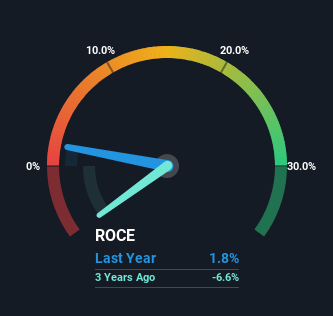
Did you know there are some financial metrics that can provide clues of a potential multi-bagger? In a perfect world, we'd like to see a company investing more capital into its business and ideally the returns earned from that capital are also increasing. If you see this, it typically means it's a company with a great business model and plenty of profitable reinvestment opportunities. In light of that, when we looked at TATSUMI (TSE:7268) and its ROCE trend, we weren't exactly thrilled.
What Is Return On Capital Employed (ROCE)?
For those that aren't sure what ROCE is, it measures the amount of pre-tax profits a company can generate from the capital employed in its business. Analysts use this formula to calculate it for TATSUMI:
Return on Capital Employed = Earnings Before Interest and Tax (EBIT) ÷ (Total Assets - Current Liabilities)
0.018 = JP¥73m ÷ (JP¥8.5b - JP¥4.5b) (Based on the trailing twelve months to December 2023).
Thus, TATSUMI has an ROCE of 1.8%. In absolute terms, that's a low return and it also under-performs the Auto Components industry average of 7.1%.
See our latest analysis for TATSUMI

Historical performance is a great place to start when researching a stock so above you can see the gauge for TATSUMI's ROCE against it's prior returns. If you'd like to look at how TATSUMI has performed in the past in other metrics, you can view this free graph of TATSUMI's past earnings, revenue and cash flow.
What Can We Tell From TATSUMI's ROCE Trend?
Over the past five years, TATSUMI's ROCE has remained relatively flat while the business is using 35% less capital than before. To us that doesn't look like a multi-bagger because the company appears to be selling assets and it's returns aren't increasing. In addition to that, since the ROCE doesn't scream "quality" at 1.8%, it's hard to get excited about these developments.
On another note, while the change in ROCE trend might not scream for attention, it's interesting that the current liabilities have actually gone up over the last five years. This is intriguing because if current liabilities hadn't increased to 52% of total assets, this reported ROCE would probably be less than1.8% because total capital employed would be higher.The 1.8% ROCE could be even lower if current liabilities weren't 52% of total assets, because the the formula would show a larger base of total capital employed. Additionally, this high level of current liabilities isn't ideal because it means the company's suppliers (or short-term creditors) are effectively funding a large portion of the business.
Our Take On TATSUMI's ROCE
It's a shame to see that TATSUMI is effectively shrinking in terms of its capital base. Since the stock has declined 11% over the last five years, investors may not be too optimistic on this trend improving either. Therefore based on the analysis done in this article, we don't think TATSUMI has the makings of a multi-bagger.
If you'd like to know about the risks facing TATSUMI, we've discovered 2 warning signs that you should be aware of.
While TATSUMI isn't earning the highest return, check out this free list of companies that are earning high returns on equity with solid balance sheets.
Valuation is complex, but we're here to simplify it.
Discover if TATSUMI might be undervalued or overvalued with our detailed analysis, featuring fair value estimates, potential risks, dividends, insider trades, and its financial condition.
Access Free AnalysisHave feedback on this article? Concerned about the content? Get in touch with us directly. Alternatively, email editorial-team (at) simplywallst.com.
This article by Simply Wall St is general in nature. We provide commentary based on historical data and analyst forecasts only using an unbiased methodology and our articles are not intended to be financial advice. It does not constitute a recommendation to buy or sell any stock, and does not take account of your objectives, or your financial situation. We aim to bring you long-term focused analysis driven by fundamental data. Note that our analysis may not factor in the latest price-sensitive company announcements or qualitative material. Simply Wall St has no position in any stocks mentioned.
About TSE:7268
TATSUMI
Manufactures and sells precision parts for automobiles, motorcycles, industrial machinery, etc.
Acceptable track record low.

